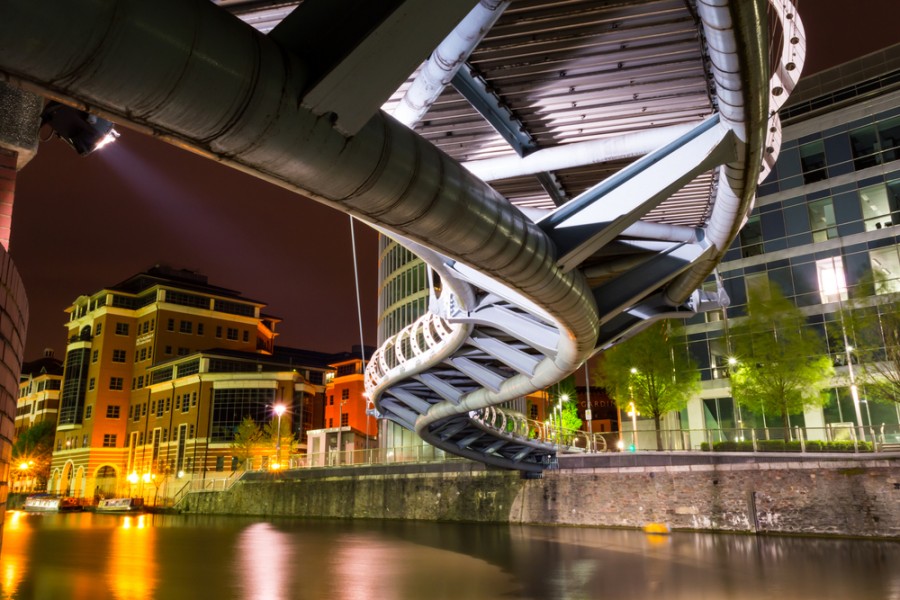Bristol is home to some of the most diverse and unique architecture in England. The city of Bristol has a rich history dating back to the 11th century, with some beautiful buildings still in existence from the 12th century. Bristol’s architecture and buildings reflect its rich heritage and culture. The city is also home to a unique style of architecture – Bristol Byzantine.
Walking around Bristol, it’s possible to see historic buildings from most architectural periods from Tudor times to current day. You will find Tudor mansions and ‘alms-houses’, salubrious Georgian squares, Victorian industrial buildings, and new modern 21st-century waterfront developments.
Of course, Bristol is also synonymous with the stunning Clifton Suspension Bridge, designed by Isambard Kingdom Brunel. And the impressive Grade I Temple Meads railway station in the heart of the city is a testimony to his ingenious engineering expertise.
What makes Bristol unique? Please read on to learn more about the distinctive architecture in this, the largest city in South West England.
Bristol Byzantine – A Unique Style of Architecture
From 1850 to 1900, Byzantine Revival architecture influenced the style of many industrial buildings in the city. This architectural style is so unique to the city that it is known as Bristol Byzantine. This specific style has influences from Byzantine and Moorish architecture.
Buildings typically have arches and arched entrances on the ground floor. You will usually see vertical or arched horizontal openings on the upper floors. One of the most spectacular examples of Bristol Byzantine is the Granary on Welsh Back. This redbrick building has colourful arched entranceways featuring red, yellow, and black bricks. The upper floors feature more arches with round exit holes.
Other notable buildings in Bristol featuring this unique architectural design include the Arnolfini, Robinson’s Warehouse, and Victoria Court.
The Architecture of Bristol Throughout the Centuries
The oldest building in Bristol – St. Mary Redcliffe – is also the tallest building at 292 feet tall. This beautiful church was built between the 12th and 15th centuries. Therefore, Bristol’s architecture goes back over 900 years, and the city has fine examples reflecting the various architectural periods.
Tudor architectural period
Large mansions dating back to the period from the 15th to 17th centuries still exist. These Tudor buildings developed when Bristol Harbour became a major trading point. Excellent examples of Tudor architecture in Bristol include Red Lodge, Bristol Cathedral and Llandoger Trow.
Stuart
The wealth generated by trade in Bristol continued to the early 18th century during the English Baroque or Stuart period. More large mansions were built for wealthy local merchants. The best examples of Stuart architecture are Kings Weston House, Goldney Hall and Royal Fort House.
Georgian architecture in Bristol
Georgian architecture is prevalent throughout Bristol, with many residential terraces dating from this period.
The Floating Harbour continued to bring prosperity to the city, and luxurious houses were constructed to meet the demands of an increasingly wealthy population. For example, Portland Square, Kings Square, and Hotwells all have examples of Georgian terraces. Many of these feature three-storey buildings set around central gardens. There are also several churches dating from this time.
Regency
Architectural styles in the early 19th century reflect elegance and wealth. In Bristol, you will find many buildings with typical features of Regency architecture. These include white-painted stucco facades, columns at entranceways, bow windows, and balconies. Many of these terraced buildings can be seen in the Cotham and Clifton areas of the city.
Victorian buildings
As Bristol expanded in the late 19th century, a plethora of industrial and residential buildings sprung up. For example, in Clifton Down are lavish villas and mansions in Italianate and Grecian Revival styles. However, many terraced streets in Bristol’s suburbs feature two-storey family homes with private gardens at the rear.
Many of the impressive buildings in the city centre of Bristol also feature Victorian architecture. For example, the Guildhall, Brunel House, Cabot Tower, and Glenside are all excellent examples of buildings built during the Victorian era.
Bristol architecture in the 20th and 21st centuries
Many areas of Bristol were bombed during the second world war. In the post-war period, modern architecture dominated the regeneration of many areas. In addition, the area around Floating Harbour was redeveloped, and many former industrial buildings were repurposed as residential buildings.
Living in Bristol
Bristol has a rich history, and the city has unique architecture you won’t find anywhere else in England. Many people choose to move to Bristol due to its thriving economy, excellent choice of housing, and vibrant communities.
If you are considering moving to Bristol or have a Bristol property for sale, give us a call at Hydes of Bristol or contact us here. Our team of local estate agents have expert knowledge of the local area that sets us apart from our competitors.
